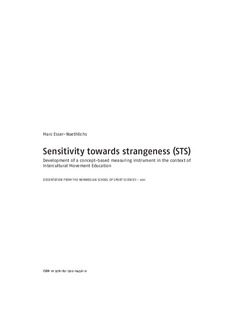| dc.contributor.author | Esser-Noethlichs, Marc | |
| dc.date.accessioned | 2011-07-06T09:37:03Z | |
| dc.date.available | 2011-07-06T09:37:03Z | |
| dc.date.issued | 2011 | |
| dc.identifier | Seksjon for coaching og psykologi / Department of Coaching and Psychology | |
| dc.identifier.isbn | 978-82-502-0456-0 | |
| dc.identifier.uri | http://hdl.handle.net/11250/171309 | |
| dc.description | Avhandling (doktorgrad) – Norges idrettshøgskole, 2011. | en_US |
| dc.description.abstract | Strangeness is a central theoretical concept within a larger research project of “Intercultural
Movement Education” (Erdmann 1999). The aim of this thesis was the development of a concept-
based device in order to measure sensitivity towards strangeness (STS). This aim required
among others that strangeness needed to be conceptualized with respect to its intended
operationalization and on the basis of Intercultural Movement Education. In order to meet
central ideas of Intercultural Movement Education, sensitivity towards strangeness was first
conceptualized as a multi-faceted construct. These theoretical considerations were the first
step to construct the “sensitivity towards strangeness questionnaire” (STSQ). The STSQ was
supposed to measure a band-width of relevant facets of strangeness. Each facet is represented
by a number of items. The developed items of each facet are not parallel items which are supposed
to measure exactly the same factor. The items are more understood as complementary
whereby each item is supposed to measure a different aspect of one facet (e.g. emotional STS,
awareness over different attributions towards strangers, openness towards strangers). The facets
are therefore kind of categories structuring a more heterogeneous pool of items. The deductively
constructed item pool was developed further with help of smaller empirical studies
which helped to improve single items and develop score-keys of the STSQ.
The STSQ was designed for research purposes only. The STSQ was developed in the first
place deductively. This concept-based construction of the STSQ allowed making predictions
of empirical results from the theory which required lower scale qualities and did not oblige
general standardization or norms of the measuring instrument (cf. Erdmann, 1988). The simplest
way the STSQ is supposed to differentiate is to check if a criteria (item) is achieved or
not (nominal scale level). In this sense, applications of the STSQ are supposed to enable for
differentiations between defined populations and can be used as a screening tool on the baseline
of the underlying theoretical concept.
However, the empirical investigations of the STSQ provided hints on validity and reliability
of the STSQ but more systematical and advanced validity and reliability analyses of the
whole instrument are required in the future. | en_US |
| dc.language.iso | eng | en_US |
| dc.subject | undervisning | en_US |
| dc.subject | læring | en_US |
| dc.subject | kroppsøving | en_US |
| dc.subject | tverrkulturell | en_US |
| dc.subject | fremmedhetintegrering | en_US |
| dc.subject | interkulturell | en_US |
| dc.subject | multikulturell | en_US |
| dc.subject | mangfold | en_US |
| dc.subject | idrett | en_US |
| dc.subject | metoder | en_US |
| dc.title | Sensitivity towards strangeness (STS): development of a concept-based measuring instrument in the context of intercultural movement education | en_US |
| dc.type | Doctoral thesis | en_US |
